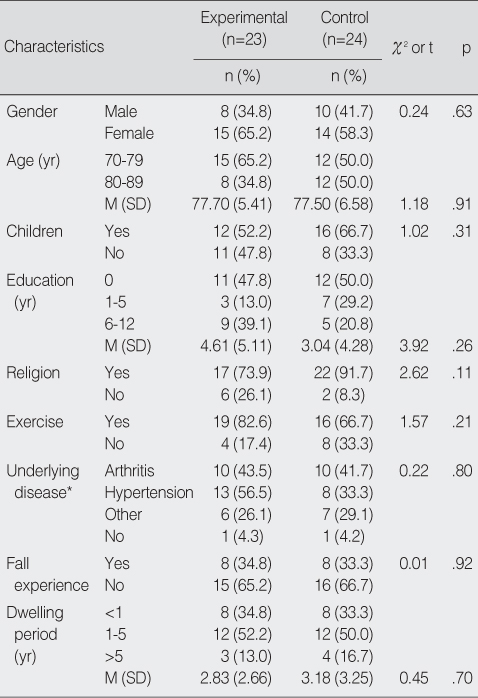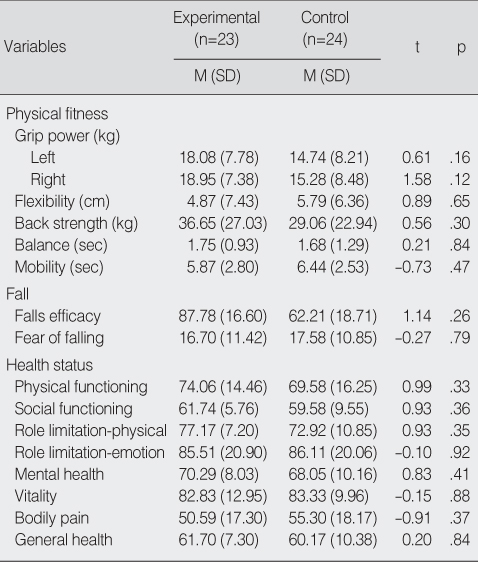Articles
- Page Path
- HOME > J Korean Acad Nurs > Volume 38(4); 2008 > Article
-
Original Article
- Effects of Tai Chi Exercise Program on Physical Fitness, Fall related Perception and Health Status in Institutionalized Elders
- MingRen Liu, Heeyoung So
-
Journal of Korean Academy of Nursing 2008;38(4):620-628.
DOI: https://doi.org/10.4040/jkan.2008.38.4.620
Published online: August 31, 2008
1Associate Professor, College of Nursing, Yanbian University, Yanbian, China.
2Professor, Department of Nursing, Chungnam National University, Daejeon, Korea.
- Address reprint requests to: So, Heeyoung. Department of Nursing, Chungnam National University, 1-6 Munhwa-dong, Jung-gu, Daejeon 301-747, Korea. Tel: 82-42-580-8325, Fax: 82-42-584-8915, hysoh@cnu.ac.kr
• Received: February 16, 2008 • Accepted: July 29, 2008
Copyright © 2008 Korean Society of Nursing Science
Abstract
-
Purpose
- The purpose was to identify the effects of a Tai Chi exercise program on physical fitness, fall related perception and health status among institutionalized elderly.
-
Methods
- A quasi-experimental research was carried out with a nonequivalent control group pretest-posttest design. There were 23 subjects in the experimental group and 24 in the control group. The data was gathered by structured questionnaires about fall related perception, and health status. Physical fitness was measured by an exercise therapist with a blind principle.
-
Results
- At the completion of the 12 weeks Tai Chi exercise program, flexibility (F=4.50, p=.00), and ability to balance (F=3.27, p=.00) had increased significantly. Fall related perception showed significant improvement in the fear of falling (F=-3.52, p=.00). Physical functioning (F=3.38, p=.00), role limitation-physical (F=2.67, p=.01), role limitation-emotional (F=2.47, p=.02). and general health (F=3.88, p=.00) in health status showed significant differences between the two groups.
-
Conclusion
- The study findings revealed Tai Chi exercise as a useful nursing intervention for elderly that enhances flexibility and balance, decreases fall related perception and also increases the health status. Further research is warranted to compare the potential effects of Tai Chi exercise and its health benefits from other types of exercise or martial arts.
- 1. Ane JS. Influences of taijiquan training moderns' mind and body health. 2002;Iksan, Wonkwang University. Unpublished master's thesis.
- 2. Chang CM. A structural model for falls and quality of life in elderly people living at home. 2005;Seoul, KyungHee University. Unpublished doctoral dissertation.
- 3. Choi JH. The effects of tai-chi exercise on physiological, psychological functions and falls among fall-prone elderly. 2002;Seoul, Catholic University of Korea. Unpublished doctoral dissertation.
- 4. Eom AY. Development and application of early rehabilitation program using Yang-style tai chi exercise for breast cancer patients after mastectomy. 2006;Seoul, Seoul National University. Unpublished doctoral dissertation.
- 5. Hong Y, Li JX, Robinson PD. Balance control, flexibility, and cardiorespiratory fitness among older Tai Chi practitioners. British Journal of Sports Medicine. 2000;34:29–34.ArticlePubMedPMC
- 6. Jeon MY, Jeong HC, Choe MA. A study on the elderly patients hospitalized by the fracture from the fall. Journal of Korean Academy of Nursing. 2001;31:443–453.ArticlePDF
- 7. Jung YS. A meta analysis of the effects of exercise programs in the elderly. 2005;Seoul, Ewha Women's University. Unpublished doctoral dissertation.
- 8. Kim J. Effects of taijiquan training on ambulation and balance for the elderly women with balance disorder. 2004;Seoul, Kuk Min University. Unpublished master's thesis.
- 9. Koh SB, Chang SJ, Kang MG, Cha BS, Pack JK. Reliability and validity on measurement instrument for health status assessment in occupational workers. Journal of Preventive Medicine. 1997;30:251–266.
- 10. Korea Social Index. 2006;11;Retrieved July 29, 2008. Korea National Statistical Office. from http://www.nso.go.kr.
- 11. Kutner NG, Barnhart H, Wolf SL, Mcneely EX. Self-report benefits of Tai Chi practice by older adults. Journal of Gerontology Series B Psychological Sciences and Social Science. 1999;52:242–246.
- 12. Lan C, Lai JS, Chen SY, Wong MK. Tai Chi chuan to improve muscular strength and endurance in elder individuals: A pilot study. Archives of Physical Medicine and Rehabilitation. 2000;81:604–607.ArticlePubMed
- 13. Lee HY. Comparison of effect among tai-chi exercise, aquatic exercise, and seif-help management programs for patients with knee osteoarthritis. 2005;Seoul, Seoul National University. Unpublished doctoral dissertation.
- 14. Pack ZM. Variables influencing the powerlessness of older residents in social welfare institutions for the aged. 2001;Seoul, Seoul Women's University. Unpublished doctoral dissertation.
- 15. Perry MC, Carville SF, Smith IC, Rutherford OM, Newham DJ. Strength, power output and symmetry of leg muscles: Effect of age and history of falling. European Journal of Applied Physiology. 2007;100:553–561.ArticlePubMedPDF
- 16. Rubenstein LZ, Josephson KR, Trueblood PR, Loy S, Harker JO, Pietruszka FM, et al. Effects of a group exercise program on strength, mobility, and falls among fall-prone elderly men. The Journals of Gerontology. Series A, Biological Sciences and Medical Sciences. 2000;55:317–321.
- 17. Ryu JH. The effect of tai-chi training on physical fitness and isokinetic strength in middle aged women. 2003;Seoul, Myongji University. Unpublished master's thesis.
- 18. Schoenfelder DP. A fall prevention program for elderly individuals. Exercise in long-term care settings. Journal of Gerontological Nursing. 2000;26(3):43–51.ArticlePubMed
- 19. Song RH, Lee EO, Lee IO. Pre-post comparisons on physical symptoms, balance, muscle strength, physical functioning and depression in women with osteoarthritis after 12-weeks Tai-Chi exercise. Journal of Rheumatology Health. 2002;9:28–39.
- 20. Tideiksaar R. Falling in old age prevention and management. 1997;2nd ed.New York, NY, Springer Publishing Co.
- 21. Tinetti ME, Richman D, Powell L. Fall efficacy as a measure of fear of falling. The Journals of Gerontology. Series A, Biological Sciences and Medical Sciences. 1990;45:239–243.
- 22. Ware JE, Sherbourne CD. The MOS 36-Item short-form health survey (SF-36). I. Conceptual framework and item selection. Medical Care. 1992;30:473–483.ArticlePubMed
- 23. Yang SC. The effect of tai-chi training on physical strength of older women. 2000;Seoul, Myongji University. Unpublished master's thesis.
REFERENCES
Figure & Data
REFERENCES
Citations
Citations to this article as recorded by 

- Effects of a fall prevention exercise regimen on physical and psychosocial outcomes in elderly community dwellers: a randomized comparative study
Ji-Yeon Sim, Jung-Wan Koo, Yeon-Gyu Jeong
Physiotherapy Theory and Practice.2025; 41(2): 252. CrossRef - Effects of a mind-body exercise intervention on anxiety, depression and quality of life in elderly patients with chronic obstructive pulmonary disease: A systematic evaluation and META analysis
Zhaoying Yan, Tao Zhang, Zifan Ding, Baole Tao, Junwen Shu, Minlei Yu, Qingyu Liang, Jun Yan
Complementary Therapies in Medicine.2025; 93: 103237. CrossRef - Current Trends of Exercise Programs for Improving Cognitive Function in Older Adults
Jae-Hyun Lee, Wooyeon Jo, Jaeho Jin, Yaxiong Zheng, Soyoon Lee, Se-Yeon Jang, Minseo Kim, Young-Jin Moon, Hye Gwang Jeong, Sang Ki Lee
Exercise Science.2024; 33(3): 254. CrossRef - Mental toughness and physical fitness tests of boxing athletes associated with big five personality factors
Ciro José Brito, Ana Lúcia dos Santos Chagas, Michele Andrade de Brito, Vanessa Teixeira Müller, Ádria Samara Noronha, Victor Coswig, Felipe Guimarães Teixeira, Dany Alexis Sobarzo Soto, Bianca Miarka
Revista Brasileira de Cineantropometria & Desempenho Humano.2023;[Epub] CrossRef - Characteristics and Effects of Fall Prevention Interventions among the Korean Older Adults: A Systematic Review
Jeong Ha Park, Hee Ju Kim
Journal of Korean Gerontological Nursing.2022; 24(1): 65. CrossRef - The effect of scapular strengthening exercise using elastic band on balance and quality of life in the old people
Sun-Young Ha, Yun-Hee Sung
Journal of Exercise Rehabilitation.2021; 17(3): 214. CrossRef - Effects of a Physical Activity Program on Physical Fitness of Intellectually Disabled Persons
Mi Seo Park, Mi Whoa Kim, Jin Hee Jeong, Nam Hyun Cha
Journal of Korean Academy of Community Health Nursing.2017; 28(1): 88. CrossRef - Effect of Strength Exercise on Patient Fall Prevention Program: Focusing on the Fall High Risk Group Elderly Patients
Hyun-Ok Lee, Byung-Hwa Lee, Chang-Hee Lee
Journal of Health Informatics and Statistics.2017; 42(4): 338. CrossRef - Effects of a Fall Prevention Program on Physical Fitness, Fall Efficacy and Fall Prevention Behavior among Community-dwelling Older Adults
Hee-Eun Jo, Myung Ja Kim
The Korean Journal of Rehabilitation Nursing.2017; 20(1): 22. CrossRef - The elderly and falls: Factors associated with quality of life A cross-sectional study using large-scale national data in Korea
Jin-Won Noh, Kyoung-Beom Kim, Ju Hyun Lee, Byeong-Hui Lee, Young Dae Kwon, Seon Heui Lee
Archives of Gerontology and Geriatrics.2017; 73: 279. CrossRef - Effect of Tai-Chi on Grip Power, Pain and Fear of Falling in Elderly Person
Chung-uk Oh
Journal of the Korea Academia-Industrial cooperation Society.2016; 17(5): 631. CrossRef - The Effects of Tai Chi Exercise on Hope, Dependency, and Perceived Health Status of Elderly Women
Yong Ju Park, Ja Ok Kim
Journal of muscle and joint health.2014; 21(2): 106. CrossRef - The Effects of Pilates Mat Exercise on the Balance Ability of Elderly Females
Ju Hyun, Kak Hwangbo, Chae-Woo Lee
Journal of Physical Therapy Science.2014; 26(2): 291. CrossRef - The Effect of Pilates Mat Exercise and Instability Support Surface Exercise on Balance for the Elderly Person Aged 65 or More
Chaewoo Lee, Hyeonsu Kim, Wonsik Bae
Journal of The Korean Society of Integrative Medicine.2014; 2(3): 75. CrossRef - Effects of Tai Chi Exercise on Physical Fitness and Quality of Life in Elderly Women
Jung Ah Park, Sook Young Kim
The Korean Journal of Rehabilitation Nursing.2014; 17(1): 38. CrossRef - Effects of Community-based Comprehensive Fall Prevention Program on Muscle Strength, Postural Balance and Fall Efficacy in Elderly People
Jeongyee Bae, Seong-il Cho
Journal of Korean Academy of Nursing.2014; 44(6): 697. CrossRef - Effects of Tai Chi Exercise on Muscle Strength, Balance, Flexibility and Bone Mineral Density of Community Dwelling Elderly Women
Heeyoung So, Kyungok Ju, Insook Park, Rhayun Song, Hyunli Kim, Sukhee Ahn
Korean Journal of Adult Nursing.2013; 25(1): 105. CrossRef - The Effects of Obesity on Fall Efficacy in Elderly People
Byoung-Jin Jeon
Journal of Physical Therapy Science.2013; 25(11): 1485. CrossRef - Effects of a Recreational Combination Gymnastics Program for Old-old Women
Yeon Hee Choi, Choon Ji Lee
Journal of Korean Academy of Nursing.2012; 42(6): 843. CrossRef - Effect of the Tai Chi Fall Prevention Program for Elderly Women Living in the Community
In Sook Park, Hee Young So, Rhayun Song, Hyunli Kim, Sukhee Ahn
Journal of muscle and joint health.2012; 19(3): 282. CrossRef - Effects of a Fall Prevention Program on Physical Functions and Psychological Functions in Rural Elderly Women
Sung-Min Kim, Go-Ya Choi
The Korean Journal of Rehabilitation Nursing.2012; 15(1): 63. CrossRef - Effects of a Fall Prevention Program on Physical Fitness and Psychological Functions in Community Dwelling Elders
Myung Soon Kwon
Journal of Korean Academy of Nursing.2011; 41(2): 165. CrossRef - Effects of a Health Diary Program on Fall-Related Outcomes in Low-Income Elderly Women with Osteoarthritis
Myung-Suk Lee
Journal of agricultural medicine and community health.2011; 36(3): 167. CrossRef - Relations among Knowledge, Fear and Efficacy of Fall in the Community Dwelling Elderly
Myung Soon Kwon
Journal of Korean Academy of Community Health Nursing.2010; 21(2): 139. CrossRef - Factors Influencing Fear of Falling in Postmenopausal Women
Sukhee Ahn, Huynli Kim, Heeyoung So, Rhayun Song
Korean Journal of Women Health Nursing.2009; 15(4): 344. CrossRef
Effects of Tai Chi Exercise Program on Physical Fitness, Fall related Perception and Health Status in Institutionalized Elders
Effects of Tai Chi Exercise Program on Physical Fitness, Fall related Perception and Health Status in Institutionalized Elders
Homogeneity Test for Demographic Characteristics
*Multiple response.
Homogeneity Test for Dependent Variables
Group Comparison of Mean Differences of Physical Fitness
Group Comparison of Mean Differences of Fall Efficacy and Fear of Falling
Gruop Comparison of Mean Differences of Health Status
Table 1
Homogeneity Test for Demographic Characteristics
*Multiple response.
Table 2
Homogeneity Test for Dependent Variables
Table 3
Group Comparison of Mean Differences of Physical Fitness
Table 4
Group Comparison of Mean Differences of Fall Efficacy and Fear of Falling
Table 5
Gruop Comparison of Mean Differences of Health Status
 KSNS
KSNS
 E-SUBMISSION
E-SUBMISSION





 Cite
Cite

